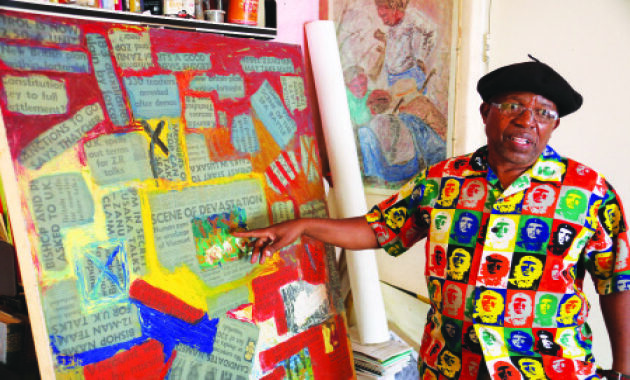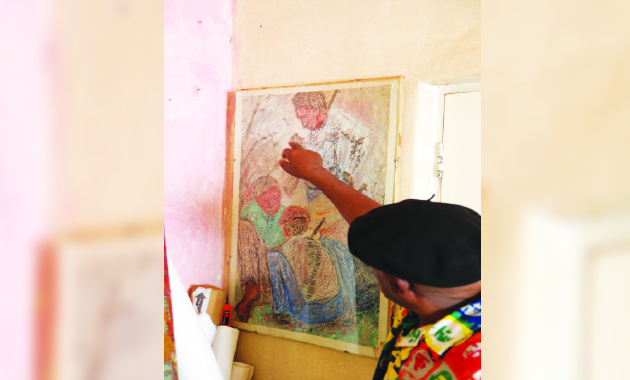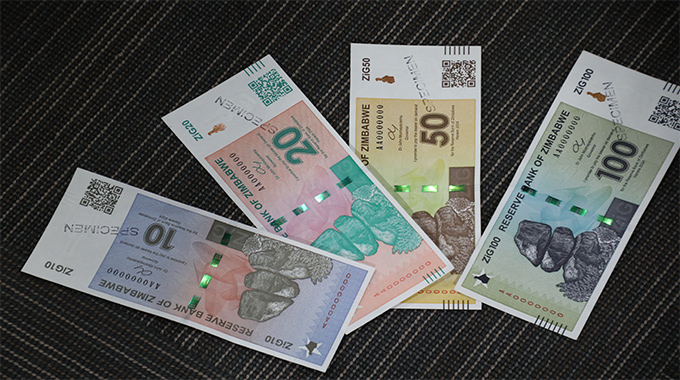WATCH: Exploring artistic evolution: A journey with Voti Thebe

Sipepisiwe Moyo, [email protected]
This week, Chronicle Showbiz embarked on a captivating journey to Queens Park West, where we were honoured to spend time with the esteemed legend, Voti Thebe in the comfort of his home.
With a diverse array of talents encompassing sculpture, painting, graphic design, performance and textile artistry, Thebe’s multifaceted career has left an indelible mark on Zimbabwe’s art scene.
Notably, he served as the regional director of the National Gallery of Zimbabwe in Bulawayo for 44 years, adding a layer of administrative prowess to his artistic repertoire.
The luminary welcomed us into his home on Wednesday morning with gracious hospitality, inviting us to immerse ourselves in the world of creativity and expression that he has cultivated over the years.
As we stepped in, we were greeted with a sense of reverence and anticipation. Our visit promised not only a glimpse into the life of a renowned artist but also an opportunity to delve into the rich tapestry of his experiences and insights, pre and post-independence.
As we sat down with Thebe, the conversation flowed effortlessly, punctuated by moments of laughter, introspection and profound reflection. Against the backdrop of his home, adorned with vibrant artworks and mementos of a storied career, Thebe shared anecdotes and memories that offered a glimpse into his remarkable journey as an artist.
He detailed how his journey in the art industry commenced during his formative years in primary school, where his innate artistic talent began to blossom. Describing it as a spiritual gift and more of a calling than a mere profession, Thebe’s passion for art became evident at an early age.
In 1964, his aspirations to pursue formal art education were thwarted when he failed to secure a place at Cyrene Mission, the sole black school offering art instruction. Despite this setback, Thebe’s determination remained unwavering. He subsequently enrolled at the Mzilikazi Art Centre, immersing himself in the world of fine art, particularly drawing and painting, before transitioning to sculpting.
Despite his training, employment opportunities remained elusive, leading him to find work in the textile industry. It was not until later that he found his niche in the art world, securing a position at the gallery that would ultimately shape his artistic legacy.
Initially honing his skills in drawing and painting, Thebe later transitioned to sculpting, marking the inception of his illustrious artistic career.
Thebe recounted his discreet pursuit of artistry while employed as a general hand.
“I initially started as a general hand at the gallery, keeping my artistic abilities a secret from my colleagues. The gallery was predominantly overseen by white individuals, and I feared jeopardising my job security if they were to discover my true talents,” Thebe narrated.
Concealing his artistic talents from his superiors, he clandestinely honed his craft until his participation in live drawing classes unveiled his true potential.

Voti Thebe shows one of his liberation work that was banned
“However, my cover was eventually blown when live drawing classes commenced. Despite my initial apprehension, I seized the opportunity to showcase my skills, which led to my inclusion in the live drawing sessions. This marked a significant turning point for me, bolstering my confidence, igniting my creativity, and affirming my identity as an artist,” he shared.
This pivotal moment fuelled his ambition, culminating in his inaugural solo exhibition at Granada Gallery in 1979, amidst the backdrop of Zimbabwe’s liberation struggle.
“With new-found determination, I embarked on a journey towards my first solo exhibition, a milestone achievement that materialised in 1979 amidst the turmoil of the liberation war. My exhibition took place at the Granada Gallery, located at the intersection of Robert Mugabe and Ninth Ave, a site now occupied by Chicken Inn in Bulawayo.”
Despite the challenges posed by the Rhodesian era, Thebe persevered, refusing to compromise his artistic integrity to appease colonial sensibilities. He recalled the struggle for recognition faced by black artists during this period, underscored by societal prejudices and limited opportunities for self-expression.
“During the Rhodesian era, recognition for black artists was scarce, with only a handful, such as the late Lazarus Khumalo, emerging as prominent figures. Expressing oneself fully was often stifled by societal constraints, as evidenced by my experience with a particular drawing depicting guerrilla fighters. This artwork, which portrayed a guerrilla carrying an AK rifle, was met with disapproval locally due to its association with the armed struggle.
“Undeterred, I took the drawing to Harare myself, recognising its historical significance despite its controversial nature. Though rejected by some, I have preserved it as a testament to the challenges faced by black artists during that tumultuous period.”
However, Thebe remained steadfast, resisting societal norms to create art that resonated with his authentic voice.
The dawn of Zimbabwe’s independence in 1980 heralded a new era of artistic liberation and opportunity. Thebe vividly recalls the palpable sense of optimism and empowerment that permeated the nation, catalysing a major shift in the arts landscape. With new-found freedom to express black identity and narratives, Thebe embraced this transformative period, channelling his art towards themes of emancipation and cultural pride.
“The advent of the armed struggle marked a pivotal moment in our nation’s history, culminating in Independence and ushering in a new era of opportunity and freedom. Among the many avenues opened up by Independence was the ability for black individuals to reside within the Central Business District, a privilege previously denied to them. “With new-found access to literature on black emancipation, including works by Martin Luther King, Jr, I found inspiration to create art that reflected the struggles and triumphs of our people.
“Prior to 1980, the collections at the gallery were predominantly curated by whites, with only a handful of works by black artists showcased. This disparity underscored the need for greater representation and recognition of black artistic contributions, a cause that I continue to champion to this day.”
Post-independence, Thebe noted significant advancements in the arts sector, buoyed by government initiatives to empower black artists and promote indigenous cultural heritage. He said the expansion of performance venues and international opportunities provided unprecedented platforms for artistic expression, enabling him and others to showcase their talent on a global stage.
“Independence for the art sector brought fantastic rewards. After independence, there was a noticeable shift in the government’s approach towards empowering the black community, including within the art sector. The National Gallery responded by acquiring diverse artworks, such as Ndebele beadwork, including a collection named ‘Love Letters’. This marked a significant step towards celebrating and preserving Zimbabwe’s rich cultural heritage.”
Personally, Thebe reflected on his global travels as an artist, citing it as another positive outcome of independence – a testament to the new-found opportunities and recognition afforded to Zimbabwean artists on the world stage.
As Thebe reflects on his remarkable journey, he remains committed to preserving Zimbabwean cultural heritage and inspiring future generations of artists.












Comments